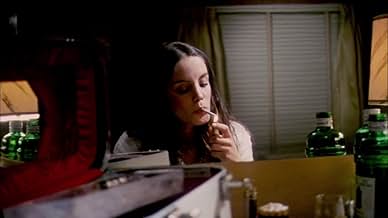Adicionar um enredo no seu idiomaA beautiful stripper hires renowned criminals to exact revenge on those who raped her in her motel room.A beautiful stripper hires renowned criminals to exact revenge on those who raped her in her motel room.A beautiful stripper hires renowned criminals to exact revenge on those who raped her in her motel room.
- Direção
- Roteiristas
- Artistas
- Direção
- Roteiristas
- Elenco e equipe completos
- Produção, bilheteria e muito mais no IMDbPro
Avaliações em destaque
What I like about this movie? First, the director goes to great length to make us care for the characters. Character development is excellent. The setting is good too. A small town in Québec, ruled by snowmobiles and beer drinking locals at the tavern. I like the documentary style used by Denys Arcand. Great way to show the exploitation of the people working in the textile industry. And great way to show the exploitation of the people, period. As the movie progress, we see that exploitation can take different forms. Gina is not too different from Dolorès, or from the four guys making a film, or from the hotel owner's wife for that matter. I also like the setting just before the gang-rape scene. When Gina is in her room and we hear the snowmobiles arriving. You can just feel the tension.
What I didn't liked about the movie? As for other Québec films, some scenes takes forever. I mean, do we really have to see an entire game of pool? Denys Arcand could have probably do this movie in 80-85 minutes, without missing anything.
Out of 100, I give it 84. That's good for *** out of ****. Seen at home, in Toronto, on December 17th, 2002.
What I didn't liked about the movie? As for other Québec films, some scenes takes forever. I mean, do we really have to see an entire game of pool? Denys Arcand could have probably do this movie in 80-85 minutes, without missing anything.
Out of 100, I give it 84. That's good for *** out of ****. Seen at home, in Toronto, on December 17th, 2002.
While Gina is a solid entry in the 70's film canon of chicks who get brutal revenge on men who rape them, it is also quintessentially Canadian (or, more accurately, Quebecois). All of the classic elements are there - the slow pacing which builds to the explosive last act, the electric guitar title music, the star getting naked, the gang-rape, the muscle car chase, the bloody finale...except in this case the setting is a town in Quebec in the middle of winter, the gang rides snowmobiles instead of motorcycles - and there is a film crew attempting to make a documentary expose on the local exploitive textile mill. Gina has a great socio-realist feel, AND a roaring purple Plymouth 383 Roadrunner. Yes!
I recently came upon this film and recognized the director Denys Arcand's name from the highly praised but controversial Jesus of Montreal, a movie about a modern telling of the Passion Play.
This was made fourteen years earlier by Arcand and it is much different from his later work.
A stripper named Gina is working at a club while at the same time a film crew is making a documentary about a labor dispute at a textile factory.
I am aware of our union struggle here in the United States but I know very little of a similar history of our neighbors to the north.
Some of the story uses black and white imagery during interviews with the textile workers and the style reminded me of John Sayles work in Matewan, another excellent film.
Gina is an unexpected little gem.
This was made fourteen years earlier by Arcand and it is much different from his later work.
A stripper named Gina is working at a club while at the same time a film crew is making a documentary about a labor dispute at a textile factory.
I am aware of our union struggle here in the United States but I know very little of a similar history of our neighbors to the north.
Some of the story uses black and white imagery during interviews with the textile workers and the style reminded me of John Sayles work in Matewan, another excellent film.
Gina is an unexpected little gem.
"Gina," a Canadian film from 1975, is a curious beast. On the surface, it ticks all the boxes of a typical rape-revenge exploitation film of its era. However, beneath the surface, it offers a unique and compelling narrative that explores broader ideas and themes.
The story follows the title character, Gina, a stripper who is sent to perform at a rural bar in the middle of winter. When she is brutally attacked, she embarks on a violent mission of revenge with the help of her pimp and their henchmen.
What sets "Gina" apart from its contemporaries is director and co-writer Denys Arcand's approach to the material. Arcand, known for his thought-provoking films like "The Barbarian Invasions," uses the exploitative elements as a hook to delve into deeper territory. The sex and violence are undeniably attention-grabbing, but they serve a greater purpose in this film.
"Gina" is an intriguing blend of arthouse and grindhouse. It's a film that challenges its audience, offering a unique take on the revenge narrative. The grit and grime of the setting and the brutal nature of the story are juxtaposed with a thoughtful exploration of human nature and the consequences of violence.
However, despite its ambitious approach, "Gina" falls short of being a truly remarkable film. While it has its moments of brilliance, the overall execution feels uneven. The pacing is often sluggish, and the tone veers wildly from one scene to the next. It is a film that keeps you engaged, but more in the sense of curiosity about where it will go next rather than genuine investment in the characters or their journeys.
That being said, "Gina" is worth watching for those interested in the evolution of exploitation cinema and its intersections with arthouse storytelling. The film's supplementary features, including interviews with Arcand and cast members, as well as a video essay by rape-revenge film scholar Alexandra Heller-Nicholar, provide valuable context and insights into the film's creation and impact.
In conclusion, "Gina" is a fascinating experiment in genre filmmaking that, while not entirely successful, offers a unique and thought-provoking experience.
The story follows the title character, Gina, a stripper who is sent to perform at a rural bar in the middle of winter. When she is brutally attacked, she embarks on a violent mission of revenge with the help of her pimp and their henchmen.
What sets "Gina" apart from its contemporaries is director and co-writer Denys Arcand's approach to the material. Arcand, known for his thought-provoking films like "The Barbarian Invasions," uses the exploitative elements as a hook to delve into deeper territory. The sex and violence are undeniably attention-grabbing, but they serve a greater purpose in this film.
"Gina" is an intriguing blend of arthouse and grindhouse. It's a film that challenges its audience, offering a unique take on the revenge narrative. The grit and grime of the setting and the brutal nature of the story are juxtaposed with a thoughtful exploration of human nature and the consequences of violence.
However, despite its ambitious approach, "Gina" falls short of being a truly remarkable film. While it has its moments of brilliance, the overall execution feels uneven. The pacing is often sluggish, and the tone veers wildly from one scene to the next. It is a film that keeps you engaged, but more in the sense of curiosity about where it will go next rather than genuine investment in the characters or their journeys.
That being said, "Gina" is worth watching for those interested in the evolution of exploitation cinema and its intersections with arthouse storytelling. The film's supplementary features, including interviews with Arcand and cast members, as well as a video essay by rape-revenge film scholar Alexandra Heller-Nicholar, provide valuable context and insights into the film's creation and impact.
In conclusion, "Gina" is a fascinating experiment in genre filmmaking that, while not entirely successful, offers a unique and thought-provoking experience.
"Gina" (1975) is an uneven combination of social docudrama about the working classes of Quebec and a rape-and-revenge story. For most of its running time it doesn't seem to be going anywhere, but a slam-bang action (and gore) climax redeems it somewhat. Celine Lomez's beauty and the snowy landscapes are further assets (the single greatest visual of the film may be a large, abandoned ship on a frozen river), but on the whole "Gina" is a film mostly of interest to director Denys Arcand followers: he didn't hit the big time until 11 years later, with "The Decline Of The American Empire". **1/2 out of 4.
Você sabia?
- ConexõesReferences Vidas Íntimas (1959)
Principais escolhas
Faça login para avaliar e ver a lista de recomendações personalizadas
- How long is Gina?Fornecido pela Alexa
Detalhes
Bilheteria
- Orçamento
- CA$ 360.000 (estimativa)
- Tempo de duração
- 1 h 35 min(95 min)
- Cor
- Proporção
- 1.85 : 1
Contribua para esta página
Sugerir uma alteração ou adicionar conteúdo ausente






























